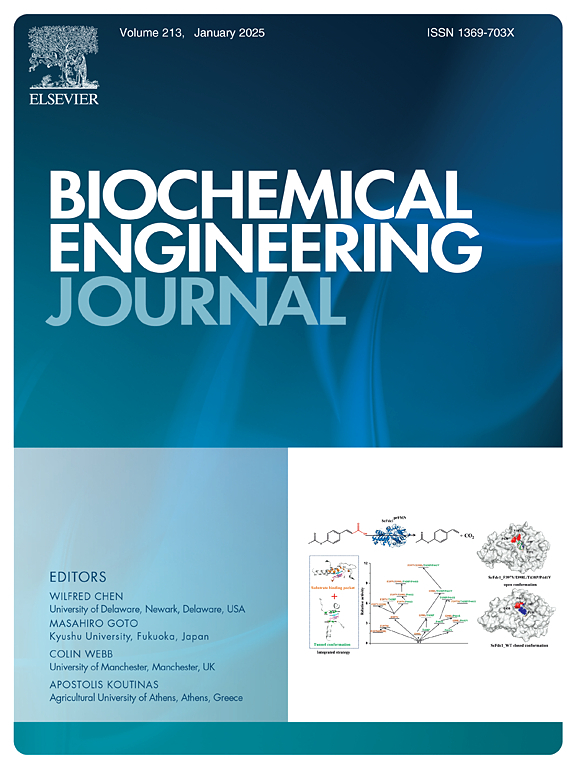糖基转移酶 PgM8 的表面显示和全细胞催化在 Pichia pastoris 中实现高效的 Rebaudioside D 生物合成
IF 3.7
3区 生物学
Q2 BIOTECHNOLOGY & APPLIED MICROBIOLOGY
引用次数: 0
摘要
甜菊糖甙 D(Reb D)是一种零热量、高甜度的甜味剂,与甜菊糖甙(ST)和甜菊糖甙 A(Reb A)等其他甜菊糖甙相比,它的口感更佳,因而备受青睐。然而,Reb D 只占甜叶菊干叶质量的 0.5%,这给生产带来了挑战。为了解决这个问题,我们在 Pichia pastoris 中共同表达了来自人参的突变糖基转移酶 PgUGT (M8)(命名为 PgM8)和来自 Vigna radiata 的蔗糖合成酶 mbSUS。我们将 PgM8 与 GPI-anchored 蛋白 GCW61 融合,用于细胞表面展示,实现了酶的固定化,从而增强了该系统。通过优化 PgM8 的拷贝数,催化活性提高了 82.56%。这一创新实现了 Reb D 合成的连续全细胞催化,消除了细胞破坏和纯化的需要,同时提高了菌株的可重复使用性。在 50 毫升的批次中,Reb D 的产量在 33 小时内达到 48.2 克/升(42.7 毫摩尔),这表明这种全细胞催化剂具有大规模工业生产的巨大潜力。本文章由计算机程序翻译,如有差异,请以英文原文为准。
Surface display of glycosyltransferase PgM8 and whole-cell catalysis for efficient Rebaudioside D biosynthesis in Pichia pastoris
Rebaudioside D (Reb D) is a zero-calorie, high-intensity sweetener favored for its superior taste profile compared to other steviol glycosides such as Stevioside (ST) and Rebaudioside A (Reb A). However, Reb D naturally accounts for only about 0.5% of the dry leaf mass of stevia, creating a production challenge. To address this, a mutated glycosyltransferase PgUGT (M8) (named PgM8) from Panax ginseng and sucrose synthase mbSUS from Vigna radiata were co-expressed in Pichia pastoris. We enhanced the system by fusing PgM8 with the GPI-anchored protein GCW61 for cell surface display, achieving enzyme immobilization. Optimizing the PgM8 copy number increased catalytic activity by 82.56%. This innovation enabled continuous whole-cell catalysis for Reb D synthesis, eliminating the need for cell disruption and purification while improving strain reusability. The yield of Reb D reached 48.2 g/L (42.7 mM) in a 50 mL batch within 33 hours, suggesting that this whole-cell catalyst has great potential for large-scale industrial production.
求助全文
通过发布文献求助,成功后即可免费获取论文全文。
去求助
来源期刊

Biochemical Engineering Journal
工程技术-工程:化工
CiteScore
7.10
自引率
5.10%
发文量
380
审稿时长
34 days
期刊介绍:
The Biochemical Engineering Journal aims to promote progress in the crucial chemical engineering aspects of the development of biological processes associated with everything from raw materials preparation to product recovery relevant to industries as diverse as medical/healthcare, industrial biotechnology, and environmental biotechnology.
The Journal welcomes full length original research papers, short communications, and review papers* in the following research fields:
Biocatalysis (enzyme or microbial) and biotransformations, including immobilized biocatalyst preparation and kinetics
Biosensors and Biodevices including biofabrication and novel fuel cell development
Bioseparations including scale-up and protein refolding/renaturation
Environmental Bioengineering including bioconversion, bioremediation, and microbial fuel cells
Bioreactor Systems including characterization, optimization and scale-up
Bioresources and Biorefinery Engineering including biomass conversion, biofuels, bioenergy, and optimization
Industrial Biotechnology including specialty chemicals, platform chemicals and neutraceuticals
Biomaterials and Tissue Engineering including bioartificial organs, cell encapsulation, and controlled release
Cell Culture Engineering (plant, animal or insect cells) including viral vectors, monoclonal antibodies, recombinant proteins, vaccines, and secondary metabolites
Cell Therapies and Stem Cells including pluripotent, mesenchymal and hematopoietic stem cells; immunotherapies; tissue-specific differentiation; and cryopreservation
Metabolic Engineering, Systems and Synthetic Biology including OMICS, bioinformatics, in silico biology, and metabolic flux analysis
Protein Engineering including enzyme engineering and directed evolution.
 求助内容:
求助内容: 应助结果提醒方式:
应助结果提醒方式:


